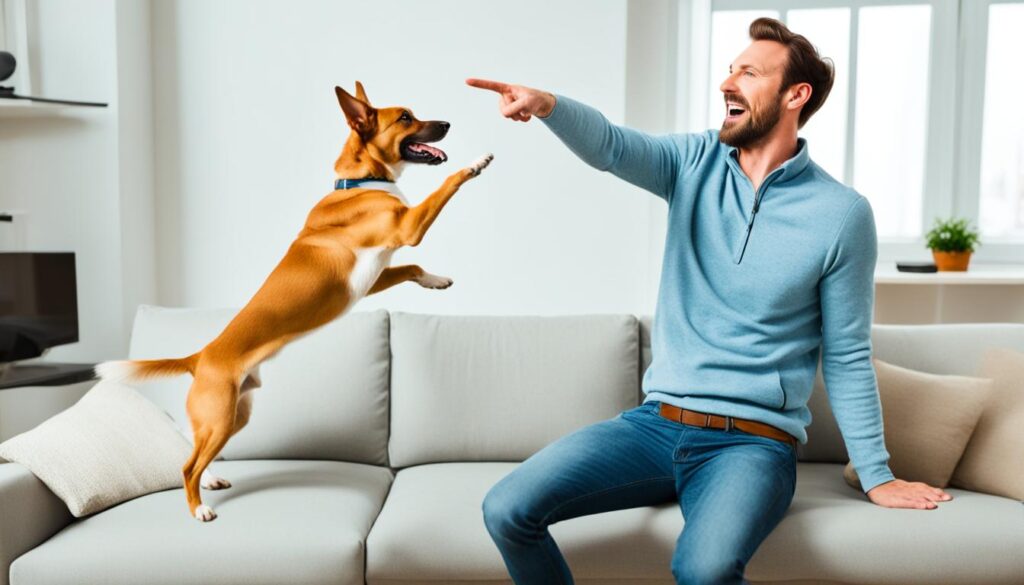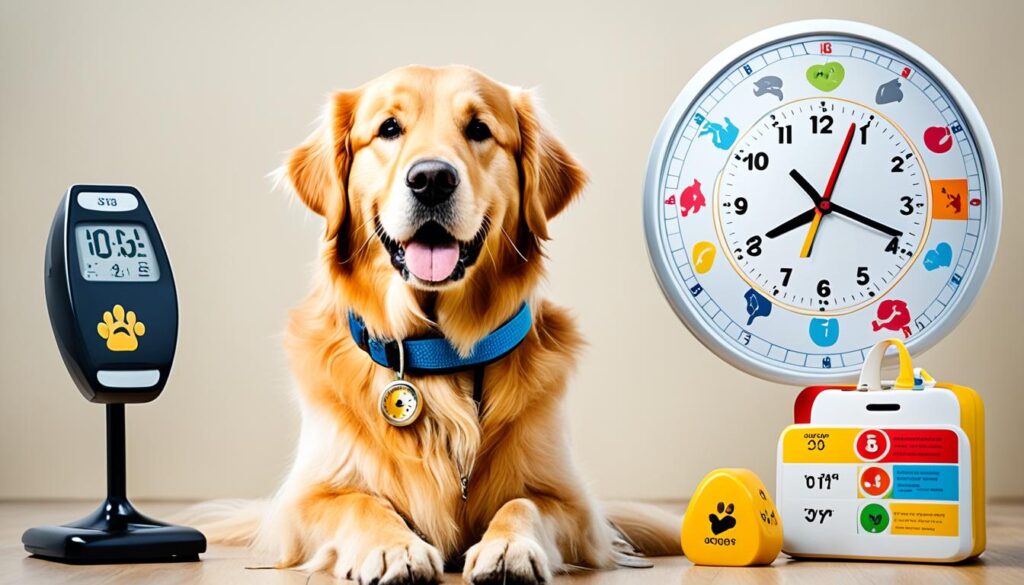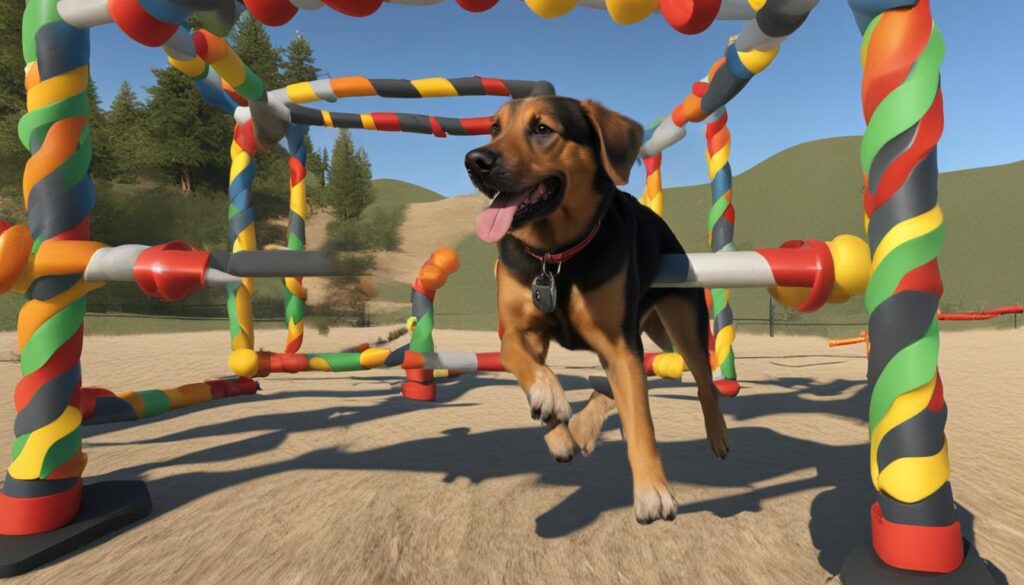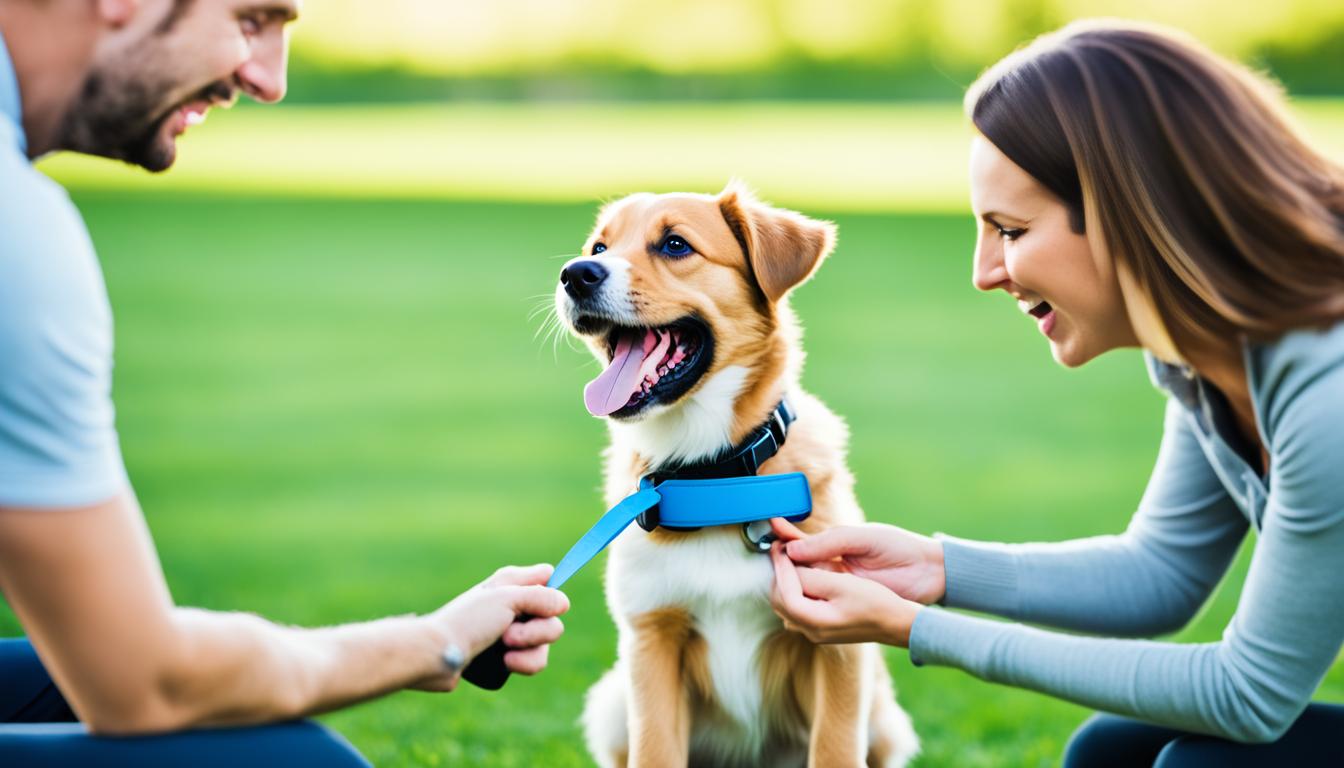Welcome to our comprehensive guide on training your pet for success. At [Company Name], we understand the importance of a well-behaved and happy pet companion. Whether you have a dog, a cat, or any other furry friend, proper pet training is essential for a harmonious coexistence.
This article will provide you with valuable insights, strategies, and techniques to help you achieve effective pet training. From understanding pet behavior to implementing positive reinforcement and establishing a consistent training routine, we will cover it all. Let’s embark on this exciting journey to unlock the secrets to successful pet behavior training together!
Key Takeaways:
- Training your pet for success requires patience, consistency, and positive reinforcement.
- Understanding pet behavior is crucial for effective training.
- Redirecting, substituting, and rewarding can pave the way to obedience.
- Positive reinforcement training involves rewarding desired behaviors.
- Establishing a training routine and incorporating it into daily activities enhances learning and behavior.
Understanding Pet Behavior: Foundation of Training
Understanding the behavior of your pet is crucial when it comes to training them effectively. By gaining insight into why pets behave the way they do, you can lay a strong foundation for successful training sessions. Let’s explore the factors that influence pet behavior and the role of reinforcement in shaping their actions.
Why Pets Behave the Way They Do
The behavior of pets is influenced by a variety of factors, including genetics, environment, and past experiences. Just like humans, pets have their unique personalities and temperaments that can impact their responses to different stimuli. Genetic factors contribute to the predisposition of certain behaviors, while the environment in which they are raised shapes their overall behavior patterns.
For example, a dog that has had positive experiences with other dogs during its early socialization period is more likely to exhibit friendly behavior towards other dogs in the future. On the other hand, a cat that has had negative experiences with loud noises may become fearful or anxious in similar situations.
The Impact of Reinforcement on Pet Behavior
Reinforcement plays a significant role in shaping pet behavior. By using positive reinforcement techniques, which involve rewarding desired behaviors, you can encourage your pet to repeat those actions. Positive reinforcement can be in the form of treats, praise, or playtime. It creates a positive association with the desired behavior, making it more likely to be repeated in the future.
On the other hand, negative reinforcement techniques, such as punishment or aversive methods, may lead to fear, anxiety, and aggression in pets. These techniques can have detrimental effects on their behavior and overall well-being. Therefore, it is crucial to focus on positive reinforcement when training your pet.
Training Your Pet for Success
When it comes to pet training, success is all about the right approach. By understanding the essential elements of training, you can set your pet on the path to success and strengthen your bond along the way. Patience, consistency, and positive reinforcement are key factors in achieving effective training outcomes.
One of the first steps in training your pet for success is setting clear goals. Determine the specific behaviors you want to teach your pet and create a plan that breaks down these behaviors into achievable steps. Having clear goals helps you stay focused and provides a roadmap for your training sessions.
Consistency is another crucial element in pet training. Pets thrive on routine, so it’s important to establish a regular training schedule. Dedicate consistent time each day to train your pet, keeping the sessions short and engaging. By maintaining a consistent training routine, you provide your pet with structure and reinforce learning.
Positive reinforcement is a powerful tool in pet training. Rewarding your pet for desired behaviors encourages them to repeat those behaviors. This can be done through praise, treats, or playtime. Incorporating positive reinforcement creates a positive association with training, making it more enjoyable for both you and your pet.
To illustrate the importance of positive reinforcement, consider this example:
When teaching your dog to sit, use a treat as a reward every time they successfully sit on command. This positive reinforcement association between sitting and receiving a reward motivates your dog to sit whenever the command is given.
Keep in mind that every pet is unique, and training methods may vary. It’s essential to adapt your approach to your pet’s individual needs and preferences. If you’re unsure about training techniques or encounter difficulties along the way, don’t hesitate to seek guidance from a professional pet trainer. They can provide expert advice and support to overcome training challenges and ensure successful outcomes.
By incorporating patience, consistency, and positive reinforcement into your pet training, you’ll be well on your way to achieving success. Remember, training is not only about teaching your pet obedience; it’s also about building a strong bond and fostering a positive relationship. Together, you and your pet can embark on a rewarding journey of growth and learning.
Redirect, Substitute, Reward: The Simple Path to Obedience
In pet training, redirecting, substituting, and rewarding can be powerful techniques in guiding your pet towards obedience. By understanding how to redirect your pet’s focus, substitute inappropriate items, and consistently reward good behavior, you can effectively shape their actions and foster a respectful and well-behaved pet.
Redirecting Your Pet’s Focus
Redirecting your pet’s focus involves shifting their attention away from unwanted behaviors and towards more desirable actions. This technique is particularly useful when you notice your pet engaging in a behavior that you want to discourage. By redirecting their attention, you can help prevent the undesired behavior from becoming a habit.
One effective way to redirect your pet’s focus is through the use of toys or treats. When you observe your pet engaging in an unwanted behavior, quickly introduce a toy or treat that captures their interest. This will redirect their attention and encourage them to engage in a more appropriate activity.

Substituting Inappropriate Items with Suitable Alternatives
In pet training, it is important to teach your pet what is acceptable to chew, scratch, or play with by substituting inappropriate items with suitable alternatives. By doing so, you can guide them towards more appropriate behaviors while preventing damage to your belongings.
For example, if your cat has a tendency to scratch the furniture, provide them with a scratching post as a substitute. Encourage them to use the scratching post by placing it near the furniture they normally target. When they use the scratching post, reward them with praise or a treat to reinforce the desired behavior.
Rewarding Good Behavior Consistently
Rewarding good behavior is a key component of effective pet training. By consistently rewarding your pet when they demonstrate desirable actions, you reinforce those behaviors and increase the likelihood of them recurring in the future.
When rewarding your pet, it is important to use positive reinforcement. This means providing them with something they find rewarding, such as treats, praise, or playtime. Make sure to deliver the reward immediately after your pet exhibits the desired behavior, so they can associate the action with the reward.
Consistency is crucial when rewarding your pet. Be sure to reward them every time they display the desired behavior, as this reinforces the connection between the action and the reward. Over time, your pet will learn to associate the behavior with positive outcomes and be more inclined to repeat it.
| Technique | Description |
|---|---|
| Redirecting | Shifts your pet’s focus from unwanted behaviors to more desirable actions. |
| Substituting | Replaces inappropriate items with suitable alternatives to encourage appropriate behavior. |
| Rewarding | Reinforces good behavior by providing positive rewards, such as treats, praise, or playtime. |
Positive Reinforcement Training: Earning Their Cooperation
In pet training, positive reinforcement is a powerful technique that can effectively shape and modify behavior. By rewarding desired behaviors, we can encourage cooperative pet behavior and strengthen the bond between pets and their owners. Let’s explore how positive reinforcement works and discover examples of effective rewards that can be used in pet training.
How Positive Reinforcement Works
Positive reinforcement involves rewarding desired behaviors to increase the likelihood of their recurrence. When a pet exhibits a behavior that we want to encourage, such as sitting on command or using the litter box, we immediately provide a reward to reinforce that behavior. This creates a positive association and motivates the pet to repeat the behavior in the future.
Some key principles of positive reinforcement include:
- Timing: The reward should be given immediately after the desired behavior to ensure a clear connection.
- Consistency: Rewards should be consistent and predictable to reinforce the desired behavior.
- Effective rewards: Rewards should be meaningful and desirable to the pet, motivating them to continue the behavior.
- Gradual fading: As the behavior becomes more consistent, the frequency of rewards can be gradually reduced.
These principles help create a positive learning environment where pets are motivated to engage in cooperative behavior.
Examples of Effective Rewards
When it comes to positive reinforcement training, choosing the right rewards is crucial to ensure their effectiveness. Here are some examples of effective rewards that can be used in pet training:
- Treats: Treats are a popular choice for rewards due to their high value and instant gratification. Use small, bite-sized treats that are both tasty and nutritious.
- Praise and affection: Verbal praise, petting, and affectionate gestures can be powerful rewards, especially for pets that are more motivated by social interactions.
- Playtime: Engaging in a favorite game or activity can be a rewarding experience for pets. Use playtime as a special reward for desired behaviors.
- Clicker training: Clicker training utilizes a clicker device to provide an auditory cue that signals a reward is coming. The clicker is paired with a treat or other rewards to reinforce positive behavior.
- Opportunities for exploration: For pets that are motivated by curiosity and exploration, rewards can include access to new toys, outdoor adventures, or interactive environments.
By understanding the individual preferences and motivations of your pet, you can tailor the rewards to their specific needs and increase the effectiveness of positive reinforcement training.
Establishing a Training Routine: Frequency and Duration
Creating a training routine for your pet is crucial for their learning and development. Consistency is key when it comes to training, and establishing a regular schedule will help reinforce behaviors and set clear expectations. In this section, we will discuss the importance of short, regular training sessions and how to incorporate training into your daily activities.
Why Short, Regular Sessions Work Best
When it comes to pet training, shorter and more frequent sessions are generally more effective than long and sporadic ones. Pets have short attention spans, and they can quickly become bored or overwhelmed if training sessions drag on. By keeping sessions short and focused, you can better hold their attention and prevent them from losing interest.
In addition, regular training sessions help with the retention of information. Just like with humans, repetition is crucial for learning. By consistently reinforcing behaviors through regular training, your pet will be more likely to remember and respond to commands in various situations.
It is recommended to start with several short sessions throughout the day, lasting no more than 10-15 minutes each. As your pet progresses and becomes more comfortable with training, you can gradually increase the duration of the sessions. Remember to always end each session on a positive note, praising your pet for their achievements.
Incorporating Training Into Daily Activities
Training doesn’t have to be limited to formal sessions alone. You can incorporate training into your daily activities to create more opportunities for learning and reinforcement. By integrating training into your pet’s daily routine, you can reinforce commands and behaviors consistently throughout the day.
Here are some tips for incorporating training into daily activities:
- During mealtime, ask your pet to sit or stay before placing their food bowl down.
- During walks, practice loose leash walking, recalling, and other commands.
- Use playtime as a reward for desired behaviors. For example, ask your dog to perform a command before throwing a ball or playing with their favorite toy.
- Integrate training into grooming sessions by asking your pet to stay or lie down calmly.
- Practice commands and obedience during everyday interactions, such as when opening the door or answering the phone.
By incorporating training into daily activities, you create a consistent and interactive environment for your pet to learn and reinforce positive behaviors. Remember to be patient and provide positive reinforcement throughout the process.

Consistency in Training: Syncing Family and Trainer Efforts
In order to achieve successful pet training, it is crucial to maintain consistency in training methods and synchronize the efforts of all family members and trainers involved. Consistency provides clear guidelines for your pet and helps reinforce desirable behaviors. By syncing efforts, you ensure that everyone is on the same page and working towards a common goal of well-behaved and obedient pets.
Here are some strategies to help you achieve consistency in your pet training:
- Establishing Clear Commands: Make sure that all family members and trainers are using the same commands for each behavior. Consistency in the choice of words and signals will prevent confusion for your pet.
- Consistent Reward System: Determine a consistent reward system for your pet’s good behavior. Whether it’s treats, praise, or playtime, make sure that all trainers are using the same rewards for the same behaviors.
- Regular Training Sessions: Set up a regular training schedule and ensure that all family members and trainers are aware of it. Consistent training sessions will help reinforce learned behaviors and promote a routine for your pet.
- Sharing Training Notes: Keep open lines of communication between family members and trainers. Share training notes and progress reports to ensure everyone is aware of any changes or updates in the training program.
- Providing Clear Expectations: Establish clear expectations for your pet’s behavior and ensure that all family members and trainers are aware of them. Consistency in expectations will help your pet understand what is acceptable behavior.
By implementing these strategies and maintaining consistency in your pet training, you will create a harmonious environment for your pet to learn and thrive. Remember, consistency is key in building a strong foundation for your pet’s obedience and well-being.
Advancing Training Techniques: Building Complexity in Stages
As we delve further into the realm of pet training, it becomes clear that advancing training techniques play a vital role in achieving success with our furry friends. By gradually building complexity in stages, we not only enhance their learning experience but also set them up for long-term behavioral improvements.
Breaking Down Behaviors Into Manageable Steps
One of the fundamental aspects of advancing pet training techniques is breaking down behaviors into manageable steps. By breaking a desired behavior into smaller, easily achievable tasks, we provide our pets with clear guidance and a sense of accomplishment as they progress. This approach allows them to understand and focus on each step, promoting steady progress and preventing overwhelm.
Breaking down behaviors into manageable steps not only enhances learning but also builds confidence and motivation in our pets.
For example, when teaching a dog to roll over, we begin by rewarding them for lying down. Once they master this step, we gradually introduce the next element, such as turning their head to one side or rolling onto their back. By gradually adding complexity, we can achieve the final behavior of a complete rollover.
Progressive Training: From Simple to Complex Commands
Progressive training is another key aspect of advancing pet training techniques. It involves starting with simple commands and gradually introducing more complex ones as our pets become proficient in each stage.
For instance, when training a dog to sit, we initially focus on getting them to understand the command and sit in a controlled environment. Once they have mastered this step, we can then introduce distractions or practice the command in different locations to generalize the behavior. This progressive approach ensures a solid foundation before moving on to more challenging commands.
By advancing training techniques through breaking down behaviors into manageable steps and progressing from simple to complex commands, we create a structured and effective training journey for our pets. This method promotes a deeper understanding of desired behaviors and empowers them to succeed through gradual and consistent learning.

Making Training an Enjoyable Experience For Your Pet
In order to ensure successful and effective pet training, it is crucial to make the experience enjoyable for your furry friend. By incorporating fun and play into the training sessions, you can elevate the learning experience and enhance your pet’s engagement and motivation.

Why Fun and Play Elevate the Learning Experience
When training your pet, it is important to create a positive and enjoyable atmosphere. Fun and play can significantly impact your pet’s learning experience by making it more engaging and rewarding. By incorporating interactive activities and incorporating playtime into the training sessions, you can create a sense of excitement and motivation for your pet.
Using Tricks to Enhance Engagement and Learning
To make training even more enjoyable for your pet, consider incorporating tricks into the sessions. Tricks not only provide mental stimulation but also serve as a means to enhance engagement and learning. By teaching your pet new tricks, you can keep their interest piqued and provide them with a sense of achievement and satisfaction.
| Benefits of Fun and Play in Pet Training |
|---|
| 1. Increases motivation and engagement |
| 2. Creates a positive and enjoyable learning environment |
| 3. Builds a stronger bond between pet and owner |
| 4. Enhances mental stimulation and problem-solving skills |
| 5. Provides a sense of accomplishment and satisfaction |
Overcoming Training Challenges With Professional Assistance
In some cases, training your pet may present challenges that require the expertise of professional pet trainers. These experienced trainers can offer valuable guidance and support to help you overcome specific training obstacles and achieve your desired results. When deciding whether to seek professional assistance, consider the following factors:
When to Consider a Professional Trainer
While many pet owners are successful in training their pets independently, there are situations where professional help may be necessary. If you encounter any of the following challenges, it may be beneficial to consult with a professional pet trainer:
- Your pet’s behavior issues are severe or persistent
- You are struggling to communicate effectively with your pet
- You lack the time or resources to dedicate to training
- Your pet has specific training needs or requirements
- You are unsure how to address certain behaviors or issues
Criteria for Selecting the Right Trainer or Class
When choosing a professional pet trainer or training class, it’s crucial to consider the following criteria to ensure you find the right fit for you and your pet:
- Experience and qualifications: Look for trainers with a solid background in animal behavior and training. They should have relevant certifications or accreditations from reputable organizations.
- Positive reinforcement approach: Verify that the trainer uses positive reinforcement techniques, which focus on rewarding and reinforcing desired behaviors rather than punishing undesirable ones.
- Good reputation and testimonials: Research the trainer’s reputation and read reviews or testimonials from previous clients. This will give you insights into their effectiveness and success rate.
- Compatibility with your pet’s needs: Ensure the trainer has experience working with your pet’s species, breed, or specific behavior issues. They should have a tailored approach that suits your pet’s unique requirements.
- Availability and location: Consider the trainer’s availability and proximity to your location. It’s essential to find someone who can accommodate your schedule and is conveniently located.
By carefully evaluating these factors and selecting the right professional trainer or class, you can overcome training challenges and provide your pet with the support and guidance needed to succeed.
Conclusion
Throughout this article, we have explored the secrets to successful pet behavior training and provided valuable insights into training your pets for success. By understanding the foundation of pet behavior and the impact of reinforcement, you can set the stage for effective training.
It is crucial to remember that training your pet requires patience, consistency, and positive reinforcement. By redirecting your pet’s focus, substituting inappropriate items, and rewarding good behavior consistently, you can pave the way to obedience.
Positive reinforcement training is a powerful tool in earning your pet’s cooperation. By understanding how positive reinforcement works and using effective rewards such as treats, praise, and playtime, you can motivate your pet and enhance their training experience.
Establishing a training routine and maintaining consistency across all family members and trainers are key to successful training outcomes. Breaking down behaviors into manageable steps and gradually building complexity through progressive training further facilitate learning and success. Additionally, making training an enjoyable experience by incorporating fun, play, and tricks can enhance engagement and motivation.
In cases where training challenges arise, professional assistance may be necessary. By knowing when to consider a professional trainer and selecting the right trainer or class based on criteria such as experience and credentials, you can overcome obstacles and achieve positive results.
In conclusion, successful pet behavior training is within your reach. By utilizing the strategies and techniques discussed in this article, you can foster a positive relationship with your pet and achieve training success. Training requires dedication and effort, but the rewards are worth it. So, start implementing these effective pet training strategies today and enjoy the benefits of a well-trained and happy pet.
FAQ
Why do pets behave the way they do?
Pet behavior is influenced by a combination of genetics, environment, and past experiences. Understanding these factors can help in training them effectively.
How does reinforcement impact pet behavior?
Reinforcement plays a crucial role in shaping pet behavior. Positive reinforcement, in particular, can be used to reinforce and encourage desired behaviors.
How can I train my pet for success?
Training your pet for success requires patience, consistency, and positive reinforcement. Setting clear goals, establishing a routine, and incorporating redirecting, substituting, and rewarding strategies can all contribute to successful training.
How can I redirect my pet’s focus?
Redirecting your pet’s focus involves diverting their attention from unwanted behaviors to more appropriate activities or toys.
What can I do to substitute inappropriate items in pet training?
Substituting inappropriate items with suitable alternatives can help encourage desirable behavior. For example, providing your cat with a scratching post instead of allowing them to scratch furniture.
How important is consistent rewarding in pet training?
Consistent rewards are crucial for reinforcing and maintaining good behavior in pets. By rewarding your pet consistently, you can strengthen the desired behaviors you want to encourage.
How does positive reinforcement training work?
Positive reinforcement training involves rewarding desired behaviors to increase their likelihood of being repeated. This can be done through treats, praise, or playtime.
What is the ideal training routine for pets?
Short, regular training sessions are more effective than long and sporadic ones. Incorporating training into daily activities can also reinforce learning and behavior.
How can I ensure consistency in training my pet?
Consistency is key in pet training. It is important to align the efforts of all family members and trainers, using consistent commands, rewards, and expectations across different training sessions.
How can I advance my pet’s training techniques?
Building complexity in stages is a great way to advance your pet’s training. Breaking down behaviors into manageable steps and gradually introducing more complex commands can facilitate learning and success.
How can I make training an enjoyable experience for my pet?
Incorporating fun and play into training sessions can elevate the learning experience and increase your pet’s engagement. Using tricks and interactive activities can also enhance motivation and learning.
When should I consider seeking professional assistance for training my pet?
It may be necessary to seek professional assistance when faced with challenges or difficulties in training your pet. A professional trainer can provide guidance and expertise to address specific training issues.
What should I consider when selecting a professional trainer or training class?
When selecting a professional trainer, consider their qualifications, experience, and training methods. Look for positive reviews and recommendations to ensure successful outcomes in your pet’s training.
Source Links
- https://smartdoguniversity.com/secrets-dog-training-success-redirect-substitute-reward/
- https://www.smalldoorvet.com/learning-center/behavior/top-10-dog-training-tips
- https://www.pethealthnetwork.com/dog-health/dog-behavior/secret-perfect-dog-training

